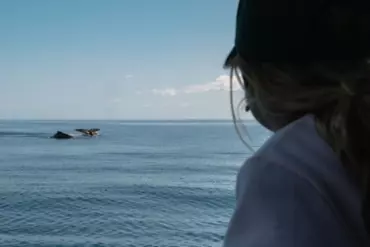Where to go swimming with whales in Queensland
Guide
By Sophia McMeekin
You’ll be hard-pressed to find a better place to go swimming with whales than Queensland.
The Sunshine State is a particularly whale-friendly place, as the home of the world’s first whale heritage site, Hervey Bay. This stretch of coastline is where humpback whales congregate in the calm, shallow waters of the Fraser Coast, en route from the Antarctic to the northern tropics. And it’s not just Hervey Bay where you’ll be able to find these giants of the deep, but all along our east coast.
While you can choose to stick to the shore or boat to gaze at whales at play, Australia is also conveniently one of a handful of countries allowing visitors a chance to safely and ethically swim alongside them. If you're ready for the experience of a lifetime, you might find yourself with just a mask and flippers between you and these majestic, wild creatures.
Where to go swimming with whales in Queensland?

You have the chance to swim with humpback whales on the Fraser Coast and Sunshine Coast from June to October. Or, visit Cairns & Great Barrier Reef to swim alongside the elusive dwarf minke whales in June and July.
The most popular is the world’s first Whale Heritage site, Hervey Bay, which has been dubbed the Whale Watching capital of the world thanks to its access to humpbacks. But Hervey Bay also offers a chance to get close and personal with the migrating population, with a small number of operators offering a chance to swim alongside them.
How to book a swimming with whales experience? Local Fraser Coast operators include family-run Hervey Bay Whale Watch and it’s specially designed vessel the Quick Cat II (with 5 viewing decks);. Hervey Bay Dive Centre takes up to a maximum of 34 people on board each trip for a more up-close experience; while Tasman Venture offers an immersive whale experience on a day tour that includes exploring the remote side of K’gari (formerly Fraser Island) - but those not keen to dive into the cool water can watch up close from underwater viewing windows.
Though not a typical 'swim with whales' experience, Blue Dolphin will get you eye-to-eye with curious whales who’ve come in for a look at their in-water immersive platform, with a hydrophone on board to listen too.
A little further south on the Sunshine Coast you’ll find pioneer Sunreef Mooloolaba, which launched swim-with-whales expeditions in 2014. Today, Sunreef offer four-hour experiences, where you’ll find yourself travelling aboard their Wild One or Tsunami vessels to swim with the whales. Nearby, Noosa Wave Boating Adventures opens their swim with whales experience to competent swimmers and snorkellers aged 16 years and older.
Make your way to the waters off Cairns & Great Barrier Reef to get better acquainted with the dwarf minke whales, the second-smallest species of whale at around eight metres. Mike Ball Dive Expeditions, Spirit of Freedom, Divers Den, and Eye to Eye Marine Encounters offer snorkelling and whale research tours, showcasing the only known congregation of dwarf minke whales in the world. Due to the remote location, these experiences are only possible in June or July and require overnight or liveaboard trips on the Great Barrier Reef.
What do you need to know about swimming with whales in Queensland?

Hervey Bay Dive Centre
Not all expeditions are the same when it comes to swimming with whales in Queensland. There are strict rules and regulations in place, both for the safety of passengers and for the safety of the whales. Some trips will let you float at the back of the boat, holding on to a tethered guide rope, while others will let you come face to face on specialised water viewing platforms.
Numbers of particpants are limited in the water at any given time and a safe distance between whale and swimmer is integral to the trip. It's up to these naturally curious creatures if they want to get closer. There’s also a chance you’ll find other marine life present - you’ll likely come across dolphins (often trailing whales along their way) and sometimes sharks. But don't worry, electronic shark shields are compulsory.
As you’re in the wild, there’s no guarantee that you’ll find whales, though sightings are incredibly common, especially around Hervey Bay. On a given trip to sea, you’ll find yourself in the water splashing about with these much-loved marine creatures half a dozen times or so, there are that many sightings.
While you’ll be in the ocean for short periods of time you will need a moderate level of swimming ability to participate. Swims are also dependent on the weather, and if conditions are too rough and deemed unsafe by your skipper, you won’t be permitted to enter the water.
When to time your trip? If you want to swim with humpback whales, visit Hervey Bay earlier in the whale watching season, between July and mid-September. Once the calves enter the bay later in the season, swimming is off limits to respect these beautiful creatures.
Ready to choose your tour? Head here.
What about scuba diving?
Consider yourself a diver? You’ll have no need for your gear here. Scuba diving isn’t permitted when swimming with humpback or minke whales as the bubbles from the oxygen tanks can scare them. Instead you’ll find yourself adorned with an ever-reliable snorkel, accompanied with a mask and fins - a non-negotiable for you to be able to navigate the currents, and (of course) get a clear look at the whales around you.
Get excited for your adventure and learn a few fun facts about our humpback whales.
You may also like


















